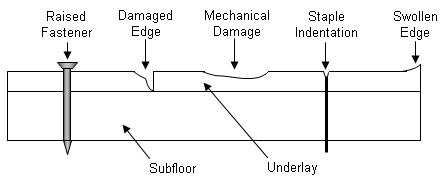Problem: Telegraphing Of Underlay Leading To Buckling Of Finishes - 2
Cause:
Poor joint and/or fastener preparation.
Resilient (vinyl) flooring must be installed on a smooth, firm base. High spots and rough areas will show through the finish if they are not sanded smooth to the same level as the rest of the floor. All fasteners must be at least flush with the surface of the underlay and penetrate to just make it through the subfloor or fasteners into joists could cause nail popping as shown in Figure 28.

Figure 28 - Typical Underlay Problems
Solutions:
Sand any ridges in the subfloor:
- If the base on which the underlay is installed is not smooth, the ridges will transfer through the underlay and the resilient (vinyl) flooring. Check the edges of the subfloor to ensure that they are smooth and level, as swelling may have taken place. If this has happened, sand the edges or replace portions of the subfloor to provide a smooth base for the underlay.
Ensure that tongue-and-groove subfloor is installed properly.
- Installing tongue-and-groove panels upside down can result in ridges in the subfloor. The tongue is designed to fit into the neighboring panel in one specific direction as shown in Figure 29. If a panel is installed upside down, the tongue may fit into the groove, but the upside down panel will be at a different height than the neighboring panel, thus creating a ridge at the interface of the two panels. Nails and staples will not have enough drawing power to pull the tow materials together. The only way to repair this problem once it has occurred is to sand ridges or replace the panel.

Figure 29 - Tongue-and-Groove Profile
Ensure underlay fasteners are properly installed.
- If fasteners are not properly installed, there is little that can be done to keep them from showing through the resilient (vinyl) flooring. Gluing panels with manufacturer's suggested adhesive in addition to stapling can help ensure proper fastening. Properly and securely set the fasteners into the underlay panel. Before you install the finish flooring, inspect the underlay and re-set any fasteners that may have lifted. Fasteners are typically countersunk slightly below the surface of the underlay and penetrate just through the subfloor.
- Follow underlayment manufacturers fastening recommendations. Some manufacturers and best practice suggests additional fasteners at 2″ (50 mm) around the perimeter and 4″ (100 mm) in the field for particle board and 3″ (75 mm) around the perimeter and 4″ (100 mm) in the field for plywood. This is dependent on the underlayment thickness.
- Place underlay panels perpendicular to the subfloor panels and offset joints to minimize any uneven areas in the subfloor. Panels should be placed with joints lightly butted together 1/16″ (2 mm) for particle board and 1/32″ (1 mm) for plywood.
- Install underlay panels with proper fasteners so that the panels do not buckle and the edges do not lift. Generally speaking, the panels should be fastened starting at one corner and fanning out to the other corners. Fully fasten underlay panels when you install them; otherwise buckling may occur. Do not tack the corners first. Leave 1/4″ to 3/8″ (8 to 9 mm) gap at walls to allow for panel expansion.
Use recommended joint filler as suggested by the underlayment manufacturer.
- Only fill joints that are 1/16″ (2 mm) or greater and allow them to dry thoroughly before applying resilient (vinyl) flooring. Attempting to patch joints that are smaller than 1/16″ (2 mm) does not allow the filler to bond to the full panel thickness; it then pops out when the underlay expands causing a ridge in the resilient (vinyl) flooring. If you cannot do a proper job filling the gap to full depth it should be left alone.
- The type of joint filler used to fill joints and holes must be compatible with both the resilient (vinyl) flooring and with the underlay. The joint filler should be a hard, quick-setting, non-shrinking patching compound. It should not affect the underlay, particularly the edges of the panel. Use a quality cement-based filler with an acrylic additive. Gypsum based fillers are not recommended. Manufacturers of resilient (vinyl) flooring have specific requirements and often manufacture their own products. Keep fillers at room temperature. Avoid storing them overnight in cold conditions.
Properly sand and dry all joins and patches.
- Properly dry and power-sand smooth joints, fasteners and other areas whether they have been patched or not. Problems can occur if the patches are sanded and the resilient (vinyl) flooring is applied before the patches have thoroughly dried.
